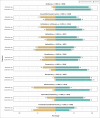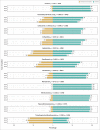Antimicrobial susceptibility of bacterial uropathogens in a South African regional hospital
- PMID: 37063604
- PMCID: PMC10091058
- DOI: 10.4102/ajlm.v12i1.1920
Antimicrobial susceptibility of bacterial uropathogens in a South African regional hospital
Abstract
Background: Urinary tract infections are common bacterial infections affecting millions worldwide. Although treatment options for urinary tract infections are well established, with ciprofloxacin long considered one of the antibiotics of choice, increasing antibiotic resistance may delay the initiation of appropriate therapy. While this increase in antimicrobial resistance has been demonstrated in multiple studies around the world, there is a dearth of information from developing countries.
Objective: This study aimed to describe the antimicrobial susceptibility patterns of commonly isolated bacterial uropathogens in a South African hospital.
Methods: Antimicrobial susceptibility data of isolates obtained from urine specimens at the RK Khan Hospital, a regional hospital in KwaZulu-Natal, South Africa, between January 2018 and December 2020 were retrieved from the hospital's laboratory information system and analysed to determine the differences in resistance rates between the most frequently isolated bacterial uropathogens.
Results: Of the 3048 bacterial urinary pathogens isolated between 2018 and 2020, Escherichia coli (1603; 53%) was the most common, followed by Klebsiella spp. (437; 14%). Both E. coli and Klebsiella spp. showed high rates of resistance to amoxicillin/clavulanic acid (29.8% and 42.3%) and ciprofloxacin (37.7% and 30.4%). Nitrofurantoin resistance was low among E. coli (6.2%) but high among Klebsiella spp. (61.3%).
Conclusion: E. coli and Klebsiella spp. in this study were highly resistant to amoxicillin/clavulanic acid and ciprofloxacin, two of the frequently prescribed oral treatment options.
What this study adds: This study highlights the importance of regular local antimicrobial resistance surveillance to inform appropriate empiric therapy.
Keywords: antibiotic resistance; antimicrobial susceptibility patterns; urinary oral treatment; urinary pathogens; uropathogens.
© 2023. The Authors.
Conflict of interest statement
The authors declare that they have no financial or personal relationship that may have inappropriately influenced them in writing this article.
Figures



References
-
- Van Schoor J. Urinary tract infection in women. S Afr Fam Pract. 2016;58(1):6–10. 10.4102/safp.v58i1.4434 - DOI
LinkOut - more resources
Full Text Sources
Miscellaneous
